Antrodia cinnamomea (synonym: Antrodia camphorata),
or Ruby Mushroom®
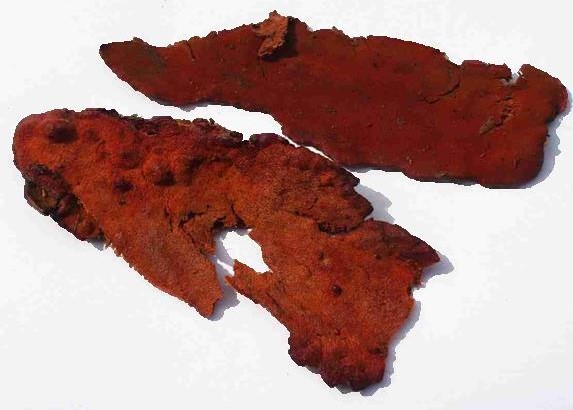 A famous folk medicine exclusively from Taiwan. In the wild, A. cinnamomea grows solely on the tree Cinnamomum kanehirai, a species of cinnamon that grows in the mountains of Taiwan. As the fruiting body only develops fully once the tree is dead, in the past many trees were felled to supply demand for this unique and extremely lucrative mushroom (wild A. cinnamomea fetches up to US$55,000/kg dry wt.) and this, coupled with the fact that C. kanehirai itself is highly sought for furniture manufacture, has led to over-exploitation, with the result that C. kanehirai is now protected by the Taiwanese government.
A famous folk medicine exclusively from Taiwan. In the wild, A. cinnamomea grows solely on the tree Cinnamomum kanehirai, a species of cinnamon that grows in the mountains of Taiwan. As the fruiting body only develops fully once the tree is dead, in the past many trees were felled to supply demand for this unique and extremely lucrative mushroom (wild A. cinnamomea fetches up to US$55,000/kg dry wt.) and this, coupled with the fact that C. kanehirai itself is highly sought for furniture manufacture, has led to over-exploitation, with the result that C. kanehirai is now protected by the Taiwanese government.
To replace the wild-collected material, commercial cultivation of A. cinnamomea has been developed using a variety of techniques to produce either cultivated fruiting body, pure mycelium (grown by sub-merged fermentation), or mycelial biomass (mycelium and residual substrate). The fruiting body products are very expensive due to the slow growth rate and the component may varies from different batches of wood. The fermentation mycelial products grown in well-defined media and growth condition offering stable quality and cost-effective product.
- Hepasim®:Active compound of ACM ( cinnamomea mycelia)
Simpson Biotech has developed a proprietary sub-merged fermentation process to produce A. cinnamomea mycelia (ACM) with very high (~12%) content of active compounds Hepasim®(Antrodin A~E) protected by 37 global patents owned by Simpson Biotech. The fermentation process is well controlled for the production of consistent high quality product as dietary supplement material.
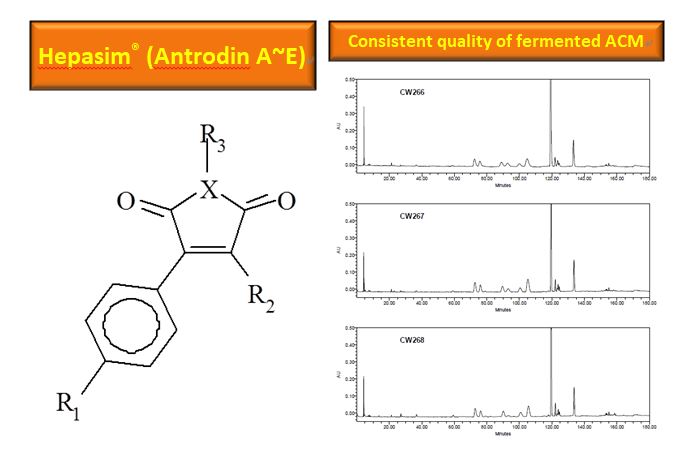
- Liver protection
ACM(A. cinnamomea mycelia), Hepasim® and Antrodin can protect the liver damage in many hepatoprotection animal models including:
- NAFLD (Non-alcoholic fatty liver disease) (CN112076187 issued, US, JP, TW patents pending)
- Alcoholic liver injury(1)
- Fulminant hepatitis model induced by Propionibacterium acnes and LPS(Toyama University, Japan)(2)
- DEN(Diethylnitrosamine) induced liver cirrhosis (National Taiwan University Hospital, Taiwan, US9572760)
- TAA(Thioacetamide) induced liver fibrosis(China Medical University, Taiwan)
- TGF-β1 induced liver fibrosis(National Cheng Kung University, US7732482, (3))(4, 5)
- CCl4(carbon tetrachloride) induced liver injury(US7109232)(5)
- D-Galactosamine induced liver injury (US7109232)
- NAFLD(Non-alcoholic fatty liver disease–
ACM, Hepasim® & Antrodin are effective for whole progress of NAFLD
 NAFLD (Non-alcoholic fatty liver disease) is a condition that fat accumulation in liver who does not consume alcohol but usually occurred in the population with overweight or obesity and also with increased risk for diabetes, high blood pressure and kidney disease. Long term fatty liver may lead to NASH (non-alcoholic steatohepatitis) due to the inflammation by the free radicals from liver fatty acid oxidation. Long-term inflammation may further damage the liver to become fibrosis with scar tissue in liver or blood vessels although still maintained liver function. Long term fibrosis may further become irreversible liver cirrhosis leading to liver failure or liver cancer. The only way for these patient to survive is liver transplantation.
NAFLD (Non-alcoholic fatty liver disease) is a condition that fat accumulation in liver who does not consume alcohol but usually occurred in the population with overweight or obesity and also with increased risk for diabetes, high blood pressure and kidney disease. Long term fatty liver may lead to NASH (non-alcoholic steatohepatitis) due to the inflammation by the free radicals from liver fatty acid oxidation. Long-term inflammation may further damage the liver to become fibrosis with scar tissue in liver or blood vessels although still maintained liver function. Long term fibrosis may further become irreversible liver cirrhosis leading to liver failure or liver cancer. The only way for these patient to survive is liver transplantation.
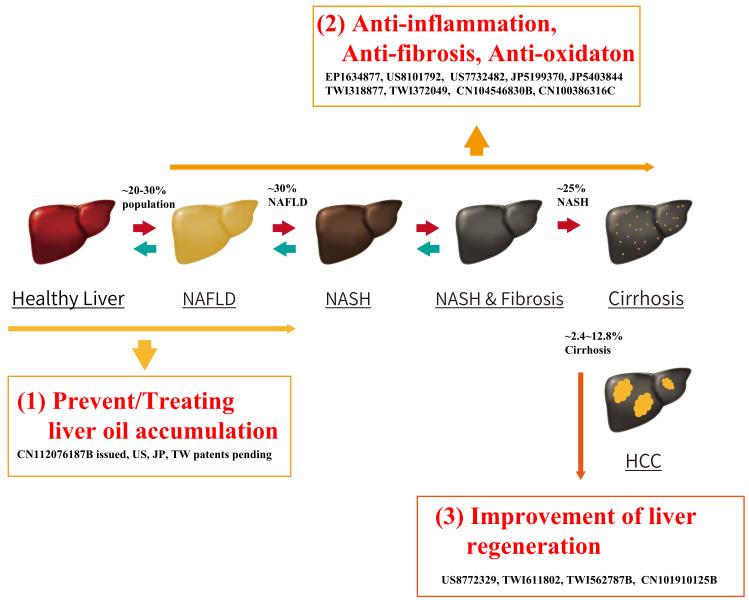
- ACM ( cinnamomea mycelia) reduce ALT, AST, AL-P, TG in fatty liver dogs
Simpson Biotech cooperate with a veterinary hospital in Japan to treat fatty liver dogs with ACM. Oral administration of ACM significantly reduced the serum ALT, AST, AL-P and TG in fatty liver dogs.
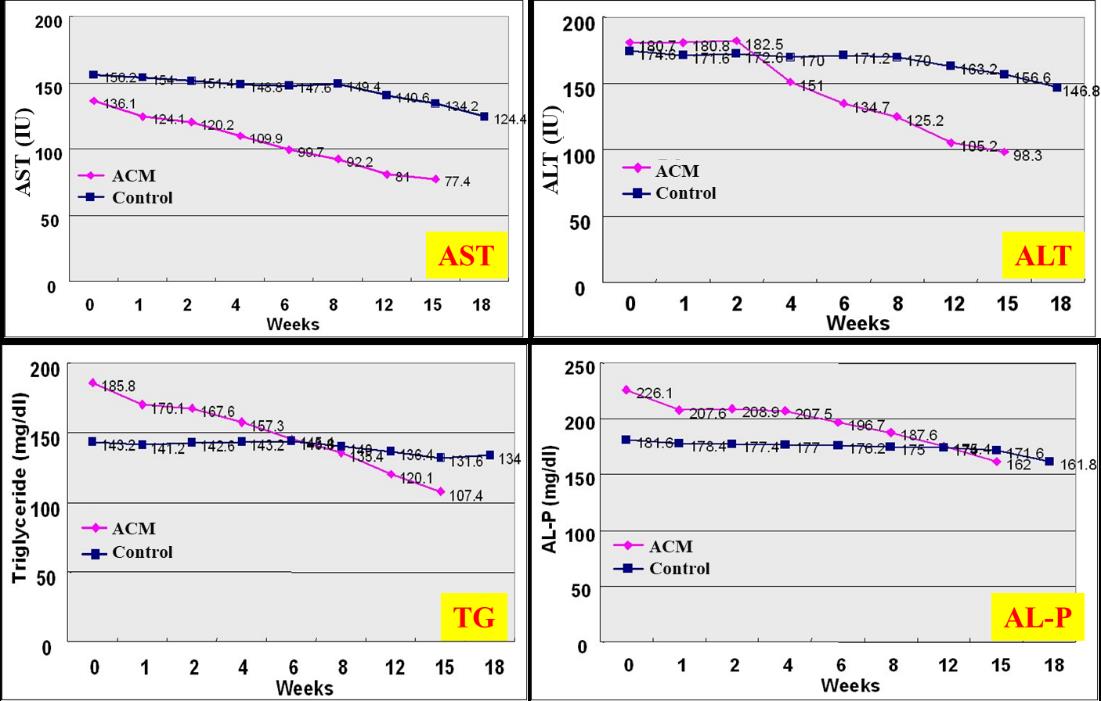
- Antrodin reverse the NAFLD (CN112076187 issued, US, JP, TW patents pending)
Mice were fed with normal or high fat diet for 20 weeks and Antrodin was administrated by gavage daily from week 11 to week 20 to evaluate the therapeutic effect of Antrodin for high fat diet induced NAFLD mice. The fatty liver and oil droplet accumulation in liver tissue caused by high fat diet was significantly reduced by oral administration of Antrodin. The serum TG, TC and blood glucose those are index for metabolic syndromes were reduced by taking Antrodin. Administration of Antrodin also reduced the serum AST, ALT suggesting the reduction of fatty liver damage and the malondialdehyde (MDA) content in liver was reduced indicating the anti-oxidation activity of Antrodin. Administration of Antrodin also reduced the elevated blood glucose caused by high fat diet.
- Hepasim® prevent the NAFLD formation (CN112076187 issued, US, JP, TW patents pending)
Simpson Biotech cooperated with National Tsing Hua University to evaluate the Hepasim®(Antrodin A~E rich ACM extract) and pure compounds Antrodins for the prevention or treatment of high fat diet induced NAFLD. Antrodin B, C, D reduced the free fatty acid induce lipid accumulation in Hep G2 cell in vitro. Oral administration of Hepasim® with high fat diet reduced the liver oil accumulation in liver. The serum AST, ALT, TG, TC were increased in high fat diet mice but significantly reduced by taking Hepasim®. In addition, the liver TG an liver TC were reduced after taking Hepasim® .
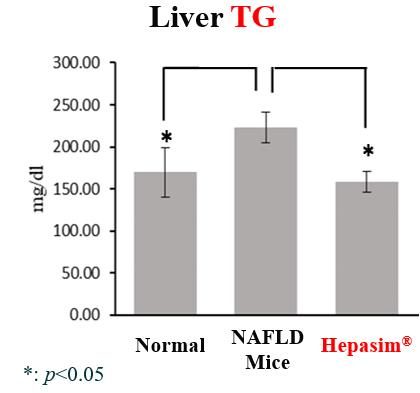
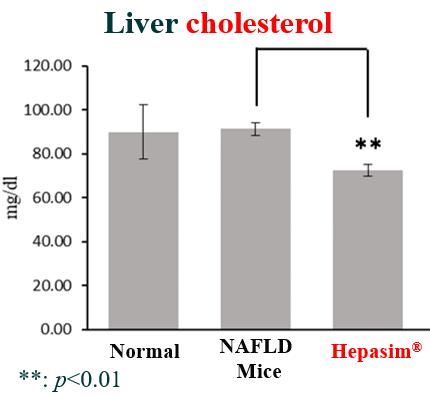
- Antrodin reverse the NAFLD (CN112076187 issued, US, JP, TW patents pending)
Mice were fed with normal or high fat diet for 20 weeks and Androdin was administrated by gavage daily from week 11 to week 20 to evaluate the therapeutic effect of Antrodin for high fat diet induced NAFLD mice. The fatty liver and oil droplet accumulation in liver tissue caused by high fat diet was significantly reduced by oral administration of Antrodin. The serum TG, TC and blood glucose those are index for metabolic syndromes were reduced by taking Antrodin. Administration of Antrodin also reduced the serum AST, ALT suggesting the reduction of fatty liver damage and the malondialdehyde (MDA) content in liver was reduced indicating the anti-oxidation activity of Antrodin. Administration of Antrodin also reduced the elevated blood glucose caused by high fat diet.
- Antrodin reduce liver oil accumulation :
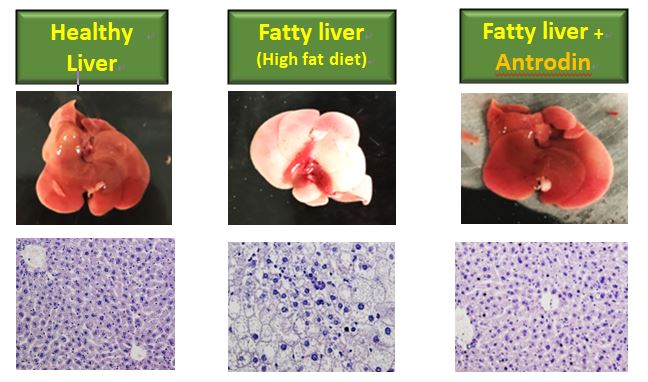
- Antrodin prevent the alcoholic liver injury
 Alcoholic hepatitis is caused by the consumption of large quantity of alcohol with syndromes of increased liver oil accumulation, elevated serum ALT, AST due to liver injury by inflammation and oxidative stress. Oral administration of Antrodin A reduced serum ALT and AST level of mice with alcoholic liver injury. Antrodin A reduce the acute alcohol induced liver oil accumulation in liver as well as the serum triglyceride(TG), total cholesterol(TC). Antrodin A reduced the alcohol-induced expression of inflammation related cytokines TNF-α, IL-1 β , IL-6, IL-17 and IFN-γ and increased the anti-inflammation cytokine IL-10. Antrodin A also increase the anti-oxidation enzyme SOD and GSH peroxidase so that reduced the MDA and increased the GSH in serum suggesting the anti-oxidation activity of Antrodin A.
Alcoholic hepatitis is caused by the consumption of large quantity of alcohol with syndromes of increased liver oil accumulation, elevated serum ALT, AST due to liver injury by inflammation and oxidative stress. Oral administration of Antrodin A reduced serum ALT and AST level of mice with alcoholic liver injury. Antrodin A reduce the acute alcohol induced liver oil accumulation in liver as well as the serum triglyceride(TG), total cholesterol(TC). Antrodin A reduced the alcohol-induced expression of inflammation related cytokines TNF-α, IL-1 β , IL-6, IL-17 and IFN-γ and increased the anti-inflammation cytokine IL-10. Antrodin A also increase the anti-oxidation enzyme SOD and GSH peroxidase so that reduced the MDA and increased the GSH in serum suggesting the anti-oxidation activity of Antrodin A.
- Anti-Fibrosis, Anti-inflammation, Anti-oxidation
- Anti-Fibrosis: Reduce collagen, a-SMA, ECM accumulation
Liver injury caused by over-diet (NAFLD), alcohol (ALD), or chemicals (TAA, CCl4, DEN, LPS et al.) induced inflammation and oxidative stress in the liver. The long-term overexpression of inflammation-related cytokines releases reactive oxygen species that continuously damage the cells and become liver fibrosis with the accumulation of collagen, a-smooth muscle actin(a-SMA) and extracellular matrix (ECM) in liver tissue. (US9572760, US7732482, (3)). Oral administration of ACM, Hepasim® or Antrodin downregulated the transforming growth factor- β1(TGF-β1) or platelet-derived growth factor-BB (PDGF-BB) induced activation of Hepatic stellate cells (HSCs) expression of fibrogenic genes including Col 1A2, Col 3, a-SMA, fibronectin to reduce the liver fibrosis(3-5).
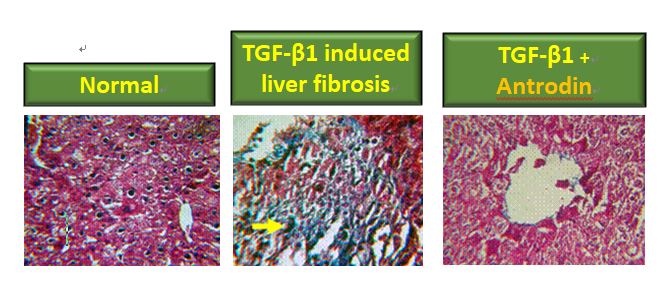
- Anti-inflammation(1, 3, 5-9)
- Inhibition of cyclooxygenase-2(COX-2) expression
- Inhibit LPS-induced NO production
- Inhibit inflammation cytokines: TNF-a, IL-1β, IL-6, IL-17, IFN-γ
- Activated the anti-inflammatory cytokine IL-10
- Anti-oxidation(1, 3, 5, 9)(US9572760, CN112076187)
ACM, Hepasim®, Antrodin increase the anti-oxidation enzymes such as catalase, superoxide dismutase (SOD), glutathione peroxidase in serum, and liver so that increased the anti-oxidant glutathione (GSH) and GSH/GSSH ratio. Antrodin improves the free radical clearance reduced the intracellular reactive oxygen species(ROS) so that reduced the malondialdehyde(MDA) in serum or liver.
Antrodin C reduced the high-glucose-induce cytotoxicity in human umbilical vein endothelial by reducing the intracellular ROS. The expression of cellular anti-oxidant genes, such as heme oxygenase-1 (HO-1) and NAD(P) H:quinone oxidoreductase 1(NQO-1) were up-regulated via the transcriptional activation by nuclear factor erythroid 2-related factor 2(Nrf2)(8)
- Improve Liver Regeneration
Oral administration of ACM enhance the liver regeneration rate to improve the recovery after surgery.
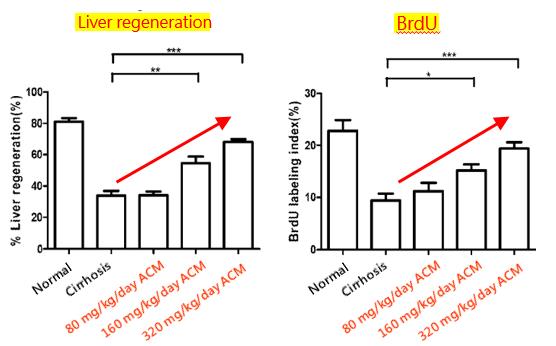
- Anti-virus
- Antrodin A & C are inhibitors for HCV & HIV protease those are involved in the replication of HCV and HIV (10)(US8703968, TWI481403).
- Antrodin B inhibited the HBV production in cell model(11).
- Antrodin A inhibit the infection of herpes simplex virus-1(HSV-1) and HSV-2 to Vero cells at a dose-dependent manner(12).
- Brain Health(9)
Accumulation of β-amyloid peptide (Aβ) in brain in major syndrome of Alzheimer’s disease(AD). Oral administration of Antrodin C reduce the amyloid plaques in AD transgenic mice by reducing the activation of glial cells and promote the Aβ clearance. Antrodin C improved the nesting behavior of AD transgenic mice suggesting the improvement of daily living skill.
- Anti-caner
- Lung cancer cell(13-15)
- Breast cancer cell(16, 17)
- Colon cancer cell(18)
Other fermented mycelia of medicinal fungus:
- Cordycep sinensis mycelia
Cordyceps sinensis is the Cordyceps species most widely used as a dietary supplement. Cordyceps sinensis is a fungus that naturally grows on the back of caterpillars. The Cordyceps fungus replaces the caterpillar tissue, eventually growing on the top of the caterpillar. The remaining structures of the caterpillar along with the fungus are dried and sold as the dietary supplement cordyceps.
Commonly known as dong chong xia cao (summer-plant, winter-worm) in Chinese, cordyceps has been used as a food supplement and tonic beverage among the rich because of its short supply. Cordyceps is also an ingredient in soups and foods used traditionally in Chinese medicine to help people recover from illness.
Ruby MaleMaxTM: male hormone stimulator
- In vivo and in vitro stimulatory effects of Cordyceps sinensis on testosterone production in mouse Leydig cells)
- In vivo stimulatory effect of Cordyceps sinensis mycelium and its fractions on reproductive functions in male mouse
- Cordyceps sinensis and its fractions stimulate MA-10 mouse Leydig tumor cell steroidogenesis
- Effects of Cordyceps sinensis on testosterone production in normal mouse Leydig cells
Ruby ImmuSimtm: immune booster
Cordyceps sinensis mycelia(CSM) extract protects mice from the infection of group A streptococcus(GAS),an pathogenic skin microbiota. Oral CSM extract greatly increased the survival rate of GAS infected mice and reduced the bacteria count in skin tissue. Streptococcal pyrogenic exotoxin B(SPE B) of can suppress the phagocytosis activity and protect group A streptococcus from the immune system of host cell. Oral CSM extract blocked the SPE Β-induced phagocytosis suppression by increasing the IL-12, IFN-r and TNF-a expression to protect cells from the infection of GAS.
Ruby Osterosimtm: anti-osteoporosis agent (US Pat. 7311919)
The estrogen declines during the menopausal transition leading to osteoporosis due to the increased bone resorption and reduced bone formation. Ruby OsteosimTM is a formulation of CSM extract which can improve the bone density in osteoporosis animal model. The ovary-removed rat simulated the menopausal induced osteoporosis and administration of CSM extract significantly recovered the bone density which may be due to the inhibition of osteoclast formation. In addition, oral ACM increased the spongy bone density in ovary-removed rat.
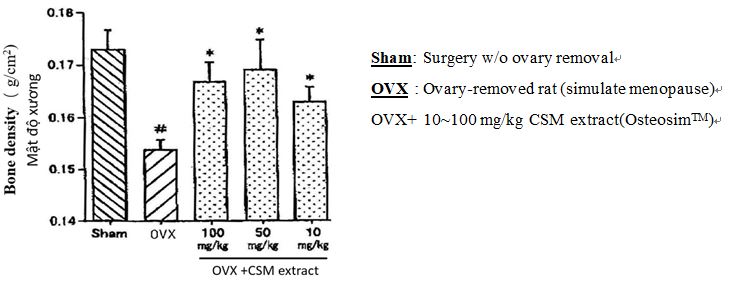
- Other mycelia & their extracts:
- Phellinus linteus
- Ganoderma lucidum
- Agaricus blazei Murill
- OEM/co-development on demand
-
- Yi, Z. W., Xia, Y. J., Liu, X. F., Wang, G. Q., Xiong, Z. Q., and Ai, L. Z. (2020) Antrodin A from mycelium of Antrodia camphorata alleviates acute alcoholic liver injury and modulates intestinal flora dysbiosis in mice. J Ethnopharmacol 254, 112681
- Han, H. F., Nakamura, N., Zuo, F., Hirakawa, A., Yokozawa, T., and Hattori, M. (2006) Protective effects of a neutral polysaccharide isolated from the mycelium of Antrodia cinnamomea on Propionibacterium acnes and lipopolysaccharide induced hepatic injury in mice. Chem Pharm Bull (Tokyo) 54, 496-500
- Yang, K. L., Chang, W. T., Hong, M. Y., Hung, K. C., and Chuang, C. C. (2017) Prevention of TGF-beta-induced early liver fibrosis by a maleic acid derivative anti-oxidant through suppression of ROS, inflammation and hepatic stellate cells activation. PLoS One 12, e0174008
- Geng, Y., Wang, J., Sun, Q., Xie, M., Lu, Z. M., Xu, H. Y., Shi, J. S., and Xu, Z. H. (2016) Identification of antrodin B from Antrodia camphorata as a new anti-hepatofibrotic compound using a rapid cell screening method and biological evaluation. Hepatol Res 46, E15-25
- Xu, X. Y., Geng, Y., Xu, H. X., Ren, Y., Liu, D. Y., and Mao, Y. (2022) Antrodia camphorata-Derived Antrodin C Inhibits Liver Fibrosis by Blocking TGF-Beta and PDGF Signaling Pathways. Front Mol Biosci 9, 835508
- Yang, S. S., Wang, G. J., Wang, S. Y., Lin, Y. Y., Kuo, Y. H., and Lee, T. H. (2009) New constituents with iNOS inhibitory activity from mycelium of Antrodia camphorata. Planta Med 75, 512-516
- Chi-LuanWen, C.-C., Shyh-ShyunHuang, Chao-LinKuo, Shih-LanHsu, Jeng-ShyanDeng, Guan-JhongHuan. (2011) Anti-inflammatory effects of methanol extract of Antrodia cinnamomea mycelia both in vitro and in vivo. Journal of Ethnopharmacology 137, 575-584
- Senthil, K. K. J., Gokila, V. M., and Wang, S. Y. (2017) Activation of Nrf2-mediated anti-oxidant genes by antrodin C prevents hyperglycemia-induced senescence and apoptosis in human endothelial cells. Oncotarget 8, 96568-96587
- Tsay, H. J., Liu, H. K., Kuo, Y. H., Chiu, C. S., Liang, C. C., Chung, C. W., Chen, C. C., Chen, Y. P., and Shiao, Y. J. (2021) EK100 and Antrodin C Improve Brain Amyloid Pathology in APP/PS1 Transgenic Mice by Promoting Microglial and Perivascular Clearance Pathways. Int J Mol Sci 22
- Phuong do, T., Ma, C. M., Hattori, M., and Jin, J. S. (2009) Inhibitory effects of antrodins A-E from Antrodia cinnamomea and their metabolites on hepatitis C virus protease. Phytother Res 23, 582-584
- Chien-Chang Shen, H.-C. Y., Ray-Ling Huang, Jinn-Chu Chen and Chien-Chih Chen. (2005) Anti-HBV principle from the culture broth of Antrodia camphorata. Journal of Chinese Medicine 16, 57-61
- He, Y. C., Lu, Z. H., Shi, P., Hao, J. C., Zhao, Z. J., Xie, H. T., Mao, P., and Chen, S. J. (2016) Anti-herpes simplex virus activities of bioactive extracts from Antrodia camphorata mycelia. Antivir Ther 21, 377-383
- Nakamura, N., Hirakawa, A., Gao, J. J., Kakuda, H., Shiro, M., Komatsu, Y., Sheu, C. C., and Hattori, M. (2004) Five new maleic and succinic acid derivatives from the mycelium of Antrodia camphorata and their cytotoxic effects on LLC tumor cell line. J Nat Prod 67, 46-48
- Wang, W., Yang, H., Deng, J., Zhu, L., Yang, Y., Liu, Z., Zhang, J. S., Tang, C., Zhang, Z., Zhuang, H., Zhang, H., and Jia, W. (2019) Increased inhibition effect of antrodin C from the stout camphor medicinal mushroom, Taiwanofungus camphoratus (Agaricomycetes), on A549 through crosstalk between apoptosis and autophagy. Int J Med Mushrooms 21, 595-610
- Yang, H., Bai, X., Zhang, H., Zhang, J., Wu, Y., Tang, C., Liu, Y., Yang, Y., Liu, Z., Jia, W., and Wang, W. (2019) Antrodin C, an NADPH dependent metabolism, encourages crosstalk between autophagy and apoptosis in lung carcinoma cells by use of an AMPK inhibition-independent blockade of the Akt/mTOR pathway. Molecules 24
- Lin, W. L., Lee, Y. J., Wang, S. M., Huang, P. Y., and Tseng, T. H. (2012) Inhibition of cell survival, cell cycle progression, tumor growth and cyclooxygenase-2 activity in MDA-MB-231 breast cancer cells by camphorataimide B. Eur J Pharmacol 680, 8-15
- Kumar, K. J., Vani, M. G., Chueh, P. J., Mau, J. L., and Wang, S. Y. (2015) Antrodin C inhibits epithelial-to-mesenchymal transition and metastasis of breast cancer cells via suppression of Smad2/3 and beta-catenin signaling pathways. PLoS One 10, e0117111
- Huang, C.-C. H., Chia-Hung; Lee, Yi-Ju; Tseng, Tsui-Hwa; Lee, Yean-Jang; Kao, Shao-Hsuan; and Wang, Chau-Jong. (2022) Camphorataimide B suppresses the metastasis of human colorectal cancer cell by inhibiting Smad/FAK/Akt axis and promoting degradation of Snail/BMP4 complex. Journal of Food and Drug Analysis 30, Article 7

